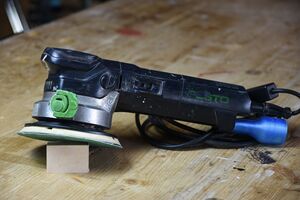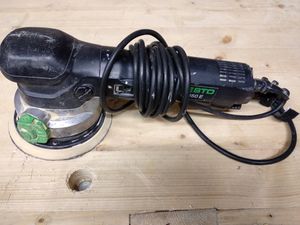Eccentric Sanders: Difference between revisions
updated commissioning |
removed commissioning |
||
| Line 12: | Line 12: | ||
}} | }} | ||
An eccentric sander is very useful for finishing surfaces. The major advantage of this kind of sander is the irregular motion of the sanding pad which greatly reduces unsightly marks on the workpiece. | An eccentric sander is very useful for finishing surfaces. The major advantage of this kind of sander is the irregular motion of the sanding pad which greatly reduces unsightly marks on the workpiece. | ||
| Line 69: | Line 46: | ||
== Festo RO 150 E == | == Festo RO 150 E == | ||
'''needs repair''' | |||
{{ToolInfoBox | {{ToolInfoBox | ||
|tool name=Festo RO 150 E | |tool name=Festo RO 150 E | ||
Revision as of 20:55, 12 December 2018
| ToolInfoBox Eccentric Sanders | |
|---|---|

| |
| Synonyms: | geared eccentric sanders, random orbital sanders, DE: (Getriebe-)Exzenterschleifer, Handscheibenschleifmaschinen |
| Type: | power tool |
| Material: | wood |
| Used with: | sanding discs |
| Access Requirements: | after they have been repaired (see #25) |
| Tutors: | Lukas |
| Similar (More or Less): | belt sander |
An eccentric sander is very useful for finishing surfaces. The major advantage of this kind of sander is the irregular motion of the sanding pad which greatly reduces unsightly marks on the workpiece.
We have a Festo RO 2 E and a Festo RO 150 E that needs to be repaired (see #25) before it can be added to the wood workshop.
Safety
When using an eccentric sander, always take the time to properly clamp down your workpiece, hook up the shop vac and wear safety glasses. Depending on your material, you may also need a dust mask!
Suggested Reading
Consumables
Sanding Discs
Typical sanding disc sizes are 120 or 150 mm. We are not currently keeping them in stock so you should be prepared to bring your own. The sanders currently available use disks with 8 holes. Bauhaus has only ones with 6 holes, however with a hole punch they can be "converted' to fit the 8 hole sander.
If you plan to remove paint, make sure to use special discs that don't clog as easily (usually with a white coating)! A spatula or a plane is usually more appropriate for this kind of work, though.
Festo RO 2 E
| ToolInfoBox Festo RO 2 E | |
|---|---|

| |
| Used with: | 150 mm sanding discs with holes |
| Location: | wood workshop |
| Access Requirements: | after personal introduction |
| Manual: | manuall.de |
The Festo RO 2 E had a broken switch when we got it, we overrode that and installed a cord switch instead. That means it has no protection against accidental turning on after you plug it in (keine Anlaufsicherung)!
Festo RO 150 E
needs repair
| ToolInfoBox Festo RO 150 E | |
|---|---|

| |
| Used with: | 150 mm sanding discs with holes |
| Location: | wood workshop (ladder shelf) |
| Access Requirements: | after repair (see #25) & personal introduction |
| Manual: | nearly identical to Festo RO 2 E (manuall.de) |